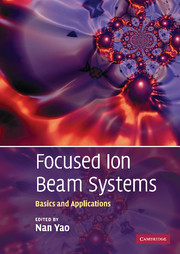Book contents
- Frontmatter
- Contents
- List of contributors
- Preface
- 1 Introduction to the focused ion beam system
- 2 Interaction of ions with matter
- 3 Gas assisted ion beam etching and deposition
- 4 Imaging using electrons and ion beams
- 5 Characterization methods using FIB/SEM DualBeam instrumentation
- 6 High-density FIB-SEM 3D nanotomography: with applications of real-time imaging during FIB milling
- 7 Fabrication of nanoscale structures using ion beams
- 8 Preparation for physico-chemical analysis
- 9 In-situ sample manipulation and imaging
- 10 Micro-machining and mask repair
- 11 Three-dimensional visualization of nanostructured materials using focused ion beam tomography
- 12 Ion beam implantation of surface layers
- 13 Applications for biological materials
- 14 Focused ion beam systems as a multifunctional tool for nanotechnology
- Index
- References
2 - Interaction of ions with matter
Published online by Cambridge University Press: 12 January 2010
- Frontmatter
- Contents
- List of contributors
- Preface
- 1 Introduction to the focused ion beam system
- 2 Interaction of ions with matter
- 3 Gas assisted ion beam etching and deposition
- 4 Imaging using electrons and ion beams
- 5 Characterization methods using FIB/SEM DualBeam instrumentation
- 6 High-density FIB-SEM 3D nanotomography: with applications of real-time imaging during FIB milling
- 7 Fabrication of nanoscale structures using ion beams
- 8 Preparation for physico-chemical analysis
- 9 In-situ sample manipulation and imaging
- 10 Micro-machining and mask repair
- 11 Three-dimensional visualization of nanostructured materials using focused ion beam tomography
- 12 Ion beam implantation of surface layers
- 13 Applications for biological materials
- 14 Focused ion beam systems as a multifunctional tool for nanotechnology
- Index
- References
Summary
Introduction
When a beam of energetic particles enters a solid, several processes are initiated in the area of interaction. A fraction of the particles are backscattered from the surface layers, whilst the others are slowed down in the solid. The collision induces secondary processes such as recoil and sputtering of constituent atoms, defect formation, electron excitation and emission, and photon emission. Thermal and radiation-induced diffusion contributes to various phenomena of mixing of constituent elements, phase transformation, amorphization, crystallization, track formation, permanent damage, and so on. Ion implantation and sputtering changes the surface morphology; craters, facets, grooves, ridges, and pyramids and/or blistering, exfoliation, and a spongy surface may develop. All those processes are interrelated in a complicated way and several processes have to be included for the understanding of individual phenomena. Therefore, it is necessary to quantitatively understand the experimental observations and to have stringent design abilities for sophisticated applications of these versatile processes in the field of nanotechnology aiming at material modification, deposition, implantation, erosion, nano-fabrication, surface analysis, and so on.
This chapter is composed of basic processes and outline of theoretical models, ion implantation and defect formation, sputtering, and surface morphology. It is focused on the recent experimental findings in the field of interaction of ions with matter and theoretical models including various simulation codes explaining the complicated experimental phenomena.
Basic processes and outline of theoretical models
General remarks
An energetic ion incident on a solid sequentially collides with constituent atoms.
- Type
- Chapter
- Information
- Focused Ion Beam SystemsBasics and Applications, pp. 31 - 66Publisher: Cambridge University PressPrint publication year: 2007
References
- 2
- Cited by



